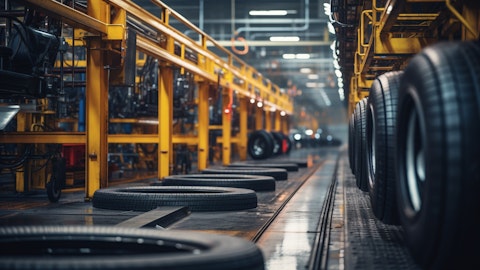As an example, in our Lawton facility, but as well as many of the other facilities to get our cost basis to a very, very competitive level, if you will, and then balancing our products across the network for looking at the best cost. So in terms of how to do that, right, all these things are tying into that working capital, as you mentioned, right? So investing in the right things at the right time, looking with purchasing in terms of how we’re negotiating that, just the 1, 2, 3s of our negotiation process, how we’re bundling when we know we’re going through a modernization period here across our equipment. If we know, for example, we’re going to go from replacing 10 machines to possibly 30, 50, et cetera, but negotiating that in upfront, so that we can get best price on that.
So we’re setting up our depreciation schedule and conserving cash upfront, but also making sure the cost structure is right, also where that equipment is being placed. The other thing is really working with our individual plant leadership teams around the world of looking at that cost efficiency level. And really, we’re starting to talk to the plant leadership teams, not only on a cost center basis, but also on a P&L basis in their window, right? So things that they can impact, and it’s things like MRO that ties up a lot of cash in a credit, if you will, around the world. So things such as shared spare part resources around the network and things like that, but again, more basic disciplined items when it comes to our spending. We have a weekly spend control as well, quite frankly, that we’ve installed, so that if anything triggers higher than that, it escalates, we talked through it.
So it’s about changing patterns and behavior, while putting the system and discipline, which we already have the systems in place, but getting the robustness of that really, really strong. Christina, do you like to hand on to that?
Christina Zamarro: No. Mark, I think you’ve covered a lot of it, I think, internally to describe what it feels like, Ryan, it is that behavioral change where what we’re emphasizing to the teams is when we get to a target it’s not that we’ve necessarily done the job. We’re going to continue to look for what else we can do. And I think it’s that never satisfied mentality. And as we’ve put together this plan, and as Mark has come in and added his experience and perspective to it, I think it’s all about achieving that sustainability and cash flow that sustainability and earnings. And when we look out to the fourth quarter of 2025, we would see an annualized cash flow on adjusted free cash flow basis of like $600 million or $700 million. And that’s on an adjusted EBITDA of, say, about 2.7. So our goal is to not, obviously, to not have a good year or two, but we’re really trying to structurally change the cash flow profile of the business.
Ryan Brinkman: Very helpful. Thank you.
Operator: [Operator Instructions] We will move next with Itay Michaeli with Citi. Please go ahead.
Itay Michaeli: Great. Thank you. Good morning, everyone. Just two follow-up questions for me. First, on the inflation and other costs, can you just maybe walk through the puts and takes for second-half of the year. I think first-half is implied to just over $40 million. I think you’ve got over $200 million of a headwind for the full-year? And then maybe going back on my second question on the assumptions for second-half for volume and pricing, hoping you could just kind of review just the underlying assumptions for industry sellout trends, maybe your market share and then maybe the impact from some of the new products, Mark, that you alluded to before. Thank you.
Christina Zamarro: Yes. Itay, I’ll start on the inflation question. And full-year cost headwinds for us of about $215 million, you rightly point out this is weighted to the second-half call base inflation every quarter, about $50 million or $55 million for us. In the first-half, we had the benefit of some lower transportation rates, particularly in the U.S. pulling through. We lapped that in the second-half of the year. And then we will put on some additional costs, because we’ve announced two factory closures in Europe, and we run that through our inefficiencies, if you will, as we scale those factories down and ready them for closure over the course of 2025 and 2026. We also have some insurance headwinds related to the tightness in the market, but also some of the claims activity that we’ve had over the last year.
So that’s the first-half, second-half story on cost. As I look at volume more broadly, and we talked through this a little bit earlier, I’d say we have good expectations for stability, I guess, I would say, in Q2, we’ve guided volume about flat. And that’s good growth in OE still continuing and maybe a little bit of weakness in replacement. And then as we look to the back half of the year — and I guess I would also say channel inventories in the U.S. and Europe are healthy. I would say the U.S. is down about 4%, compared to year-end. EMEA is down 8% on a year-over-year basis. The year-over-year comp, there is more important because we have these different seasonality’s. And all of that time, Itay, that the consumer has been resilient to sell out in Europe is up 3%, sellout in the U.S. is up — it’s been up kind of 1% or so in the last several quarters.




